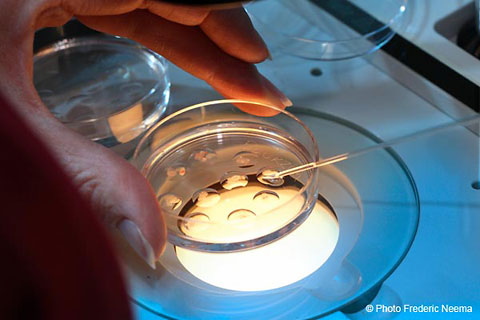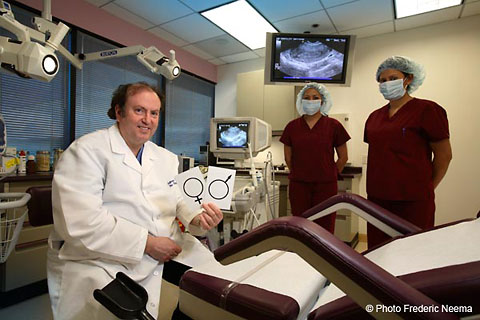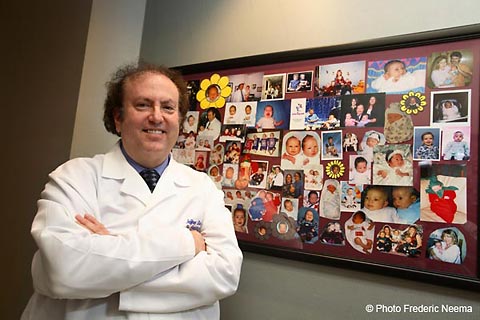How it Works

The selection of gender has been a quest of couples for as far back as recorded history allows. Early drawings from prehistoric times suggest that sex selection efforts were being investigated by our earliest ancestors. Later history shows intense interest in sex selection by early Asian (Chinese), Egyptian and Greek cultures. This is followed by documented scientific efforts beginning in the 1600's to sway the chances of achieving a pregnancy by a variety of methods.
Research and work carried out in the 1980's and 90's have finally provided methods offering the chance of obtaining a desired pregnancy gender outcome that ranges from excellent to virtually GUARANTEED. The method is as follows:
- Several eggs are extracted from the mother by our doctors, sperm is supplied by the father.
- The father's sperm is used to fertilize the mother's eggs in our lab.
- After 3 days, several 8-cell embryos will have developed.
- Our doctor-scientist specialists examine the genetic makeup of the embryos, screening for both genetic diseases and desired gender.
- Healthy embryos of the gender you desire are implanted in the mother.
- Any additional healthy embryos may be cryo-frozen for future use.
- Gestation and birth take place as normal.
Scientific Understanding of Sex Selection

It has been known for many years that the gender of a pregnancy is determined by the sex chromosome carried by the sperm. Sperm bearing an "X" chromosome, when united with the "X" from the female (females only produce "X") will result in an "XX" pregnancy that produces a female. If a sperm bearing a "Y" chromosome (men have both "X" and "Y" bearing sperm) unites with the "X" chromosome from the female, an "XY" pregnancy will result that gives rise to a male offspring.
Armed with this knowledge, science initially worked to allow for an accurate method of safely separating sperm to allow the majority of those sperm capable of producing the desired gender ("X" sperm or "Y" sperm) to be exposed to the female egg (oocyte). While a variety of methods of purifying the sperm separation process have been reported and studied, in reality, very few of these methods have withstood scientific scrutiny that "checks" the validity of claims made by those employing the procedure.
Because no sperm separation method thus far developed has produced the high level of sperm separation "X" (for female) and "Y" (for male) needed to provide gender outcome success levels greater than 90%, further work to perfect the sex selection process is being studied.
"PGD" (preimplantation genetic diagnosis) has taken sex selection to the next and most successful level ever (greater than 99.9%). Results from our PGD process far exceed reported results from any and all other processes:
Sperm that have been filtered by our standard sperm preparation process are allowed to fertilize the eggs obtained from the female "in vitro" (in our highly specialized fertility laboratory). The embryos resulting from this specialized fertilization process are then screened by our genetics team to determine both their gender and that selected chromosome pairs have resulted in an expected normal genetic pairing outcome (this process is called "aneuploidy" screening). This gender determination process at the very early development level as made famous by our Center, has resulted in the ability to provide sex selection results for the chosen gender far in excess of 99.9%.
The aneuploidy (abnormal chromosome count) screening process also employed at the time of PGD gender determination also allows for the detection of limited genetic count abnormalities as a routine or for the optional screening of the embryos for a wide variety of additional genetic abnormalities. Upon request, we can screen for genetic abnormalities such as Down's syndrome (one "extra" chromosome 21), Turner's syndrome (the absence of one of the two "X" chromosomes normally found in a female), and Kleinfelter's syndrome (a male with one "Y" chromosome and 2 "X" chromosomes instead of the normally found single "X" chromosome).
New DNA microarray technology also provides us the option of screening embryos for a full (46 chromosome) genetic count. We are also able to provide those patients known to carry specific personal or family genetic diseases the ability to screen the embryos for many specific disorders. All couples meeting our standard, liberal entrance criteria will qualify for the PGD process.
Aneuploidy screening as described above detects abnormal chromosome numbers and the diseases associated with those conditions. "Single gene disorders" include a wide variety of hereditary diseases found on a specific chromosome that can also be screened for with PGD.
Among the diseases detectable with PGD screened for by our Center:
- Adrenoleukodystrophy
- Amyotrophic Lateral Sclerosis
- Becker Muscular Dystrophy
- Beta Thalassemia
- BREAST CANCER
- Central Core Disease
- Centronuclear (Myotubular) Myopathy
- Cerebellar Ataxia
- Charcot-Marie-Tooth Disease
- Chondrodysplasia Punctata
- Congenital Aganglionic Megacolon
- Conradi-Hunnerman Syndrome
- Cystic Fibrosis
- Duchenne Muscular Dystrophy
- Factor VIII Deficiency
- Factor IX Deficiency
- Familial Spastic Paraparesis
- Fragile X Syndrome
- Friedrich's Ataxia
- Gardener Syndrome
- Glycogen Storage Disease
- Happle Syndrome
- Hemophilia
- Huntington's Disease
- Retinitis Pigmentosa
- Prostate Cancer
- Sickle Cell Anemia
- Tay-Sachs Disease
- Von Willebrand Disease
- OVER 60 OTHER DISEASES - CALL FOR DETAILS
Unlike many programs offering sex selection only to very limited couples with known genetic disorders in the family we make sex selection available to all patients. Parents have come to us from from nearly every nation on the planet (we have assisted patients from 147 different nations) seeking to balance their families or assure themselves that a pregnancy will result in ONLY the gender outcome they desire. REMEMBER: Nearly all couples qualify for sex selection using the PGD method, which provides near 100% (99.99%) success regardless of sperm counts or gender percentages!
Imagine the Following Scenarios, Which are Taken from Our Clinical Files

Couple 1: Mr. & Mrs. Adams (names are fictitious) present to our offices with a request for gender selection. The couple reports having successfully conceived and delivered three healthy females. The last birth was three years ago. Mr. Adams has a strong family history of girls being born, with his only brother having produced two girls, and three cousins also having had a total of seven female and one male offspring.
Mr. Adams underwent genetic analysis of the "sex ratio" (percentage of "X" and "Y" sperm) of his total sperm production. His ejaculate was found to contain 51% of the viable sperm seen carrying a "Y" (male producing) chromosome. His total sperm count was 38 million per ml. So, of the 38 million sperm, 51% had the correct sex chromosome needed to produce a male. After separating his sperm for the desired gender, we would be left with a sperm count of at best, 15-16 million. This would not be enough to allow for a reasonable chance of the couple conceiving with simple sperm selection and insemination.
Advised of the situation concerning their sperm sex ratio, the couple wisely elected to proceed with the IVF-PGD option. They were rewarded with a twin pregnancy that resulted in the birth of two healthy, male infants. While we exist to provide high quality medical services, we very strictly adhere to guidelines that have a history of providing excellent outcome results. While we cannot "guarantee" a desired outcome to anyone, we can now come as close to a guarantee as science allows. With the IVF-PGD option, success rates approach 100%. Couples in our program can feel comfortable that once treatment begins, they do have a nearly 100% excellent chance of achieving the desired outcome when pregnancy occurs. Consider the next scenario:
Couple 2: This British couple presented to us with a history of having produced three boys over the past seven years. With very few female offspring in either of their families, they were interested in sex selection aimed at the production of a female.
They undertook an initial telephone consultation with Doctor Steinberg that indicated their suitability for our program so long as some initial blood tests the Doctor requested were in order. The blood testing was ordered from a hospital laboratory near their home in London. One week later, the initial blood screening results showed them to be excellent candidates for the sex selection procedure. Total sperm count on the male was 88 million per ml. Sex ratio demonstrated only 38% of his sperm to be "X" (female) producing.
The couple were directed to one of the several fertility centers in London that we work with who assisted us in the preparation of the patients for the procedure. They began their procedure under the co-direction of our program working with the medical team in London. Two weeks later, they arrived in Los Angeles. Their travel and lodging arrangements had been coordinated with our travel desk who had a car meet them at the airport in Los Angeles. They were transported to the hotel they had chosen and the next morning undertook the egg harvest at our facility.
After our modified sperm preparation separation, we obtained 34 million sex selected sperm per ml. from the husband. The PGD analysis of the embryos produced after insemination of the eggs demonstrated 3 healthy female embryos and 7 healthy male embryos, along with 2 abnormal embryos. Two normal female embryos were transferred to the uterus. The couple returned home after two "extra" days of tourism in Los Angeles and two weeks later a pregnancy test was positive. A single healthy female birth resulted.
Couple 3: Lisa and David were referred to us by a local fertility program near their home in Toronto, Canada. They presented to their local program with a request to assist them in their desire to become pregnant with a boy.
Lisa underwent a tubal ligation 3 years earlier after the birth of their third daughter. Lisa and David explained that they felt that they had "reached their limit" after having 3 children and undertook the tubal ligation. They indicated that with their oldest daughters now growing older and able to help with the youngest one, their thoughts had changed and they now felt that they could care for an additional child.
While totally content with their daughters, David indicated that he was very interested in seeing if the couple could use "new science" to help them achieve the birth of a son. Lisa was very supportive and indicated that she too was ready for another child. She indicated that gender was not a concern for her but that she was ready to support David's decision to inquire about our gender selection program.
They were told by their local fertility physician that gender selection was illegal in Canada. He did advise them that he had seen and assisted in the care of several Canadian patients that were being treated for sex selection at our Center in Los Angeles. He suggested to Lisa and David that they come see us. The couple had an initial telephone based consultation with us. This was followed by the performance of blood tests and a semen analysis that was carried out by a laboratory near their home.
We performed a sex ratio on David's sperm that provides us with very valuable information about David's capacity to produce male embryos. After we learned that the couple seemed to be suitable candidates for the procedure, they underwent their initial start-up examinations at the local center. We are able to interface with physicians near the homes of patients in nearly all cases.
Because Lisa was going to be 39 years old at the time of her delivery, the couple opted to also check their embryos genetically to make sure that a pregnancy with Down's syndrome did not result.
Lisa and David achieved a successful male pregnancy that resulted in a healthy baby boy born at Toronto General Hospital. Their referring physician has sent us several additional patients and two of David's friends have now been seen with a request for gender selection.
For more information please vist The Fertility Institutes website.
